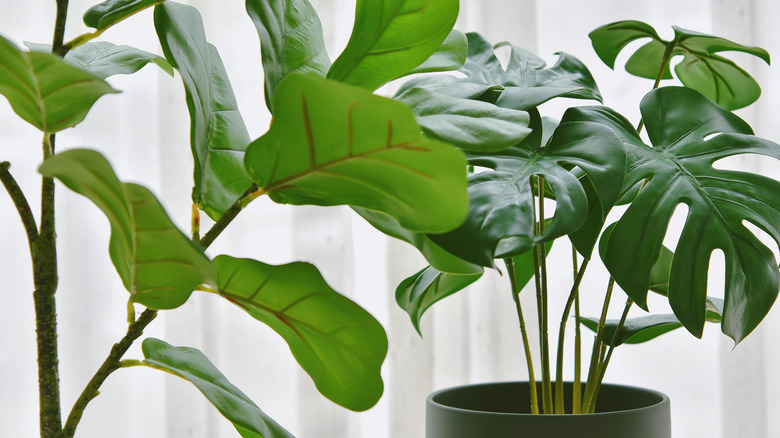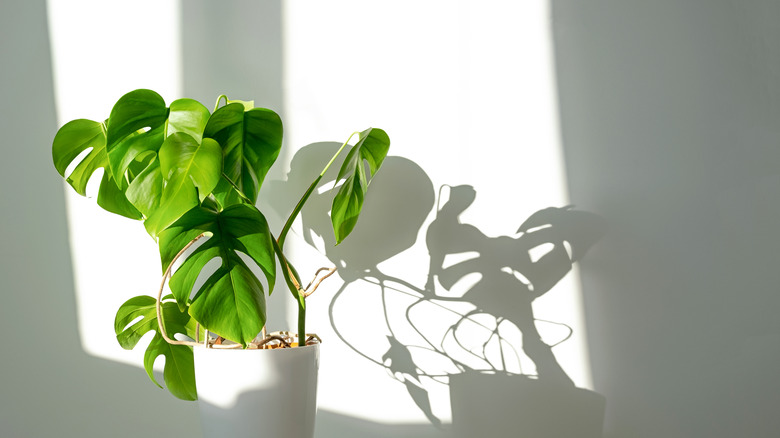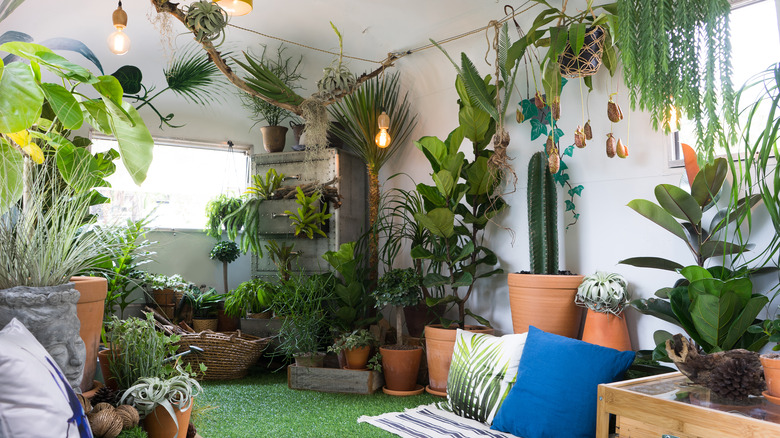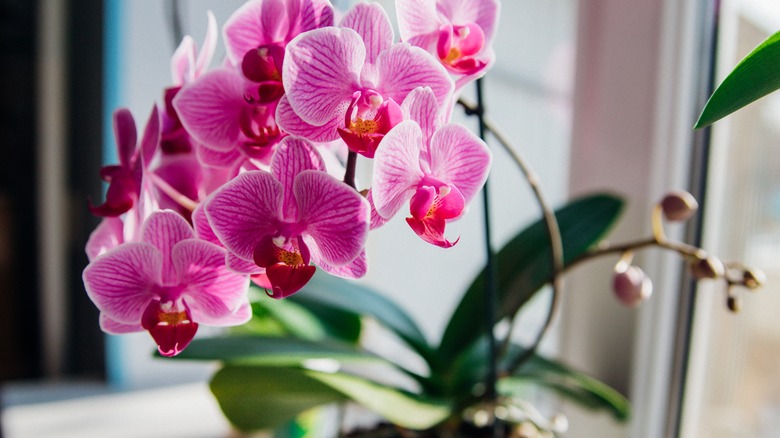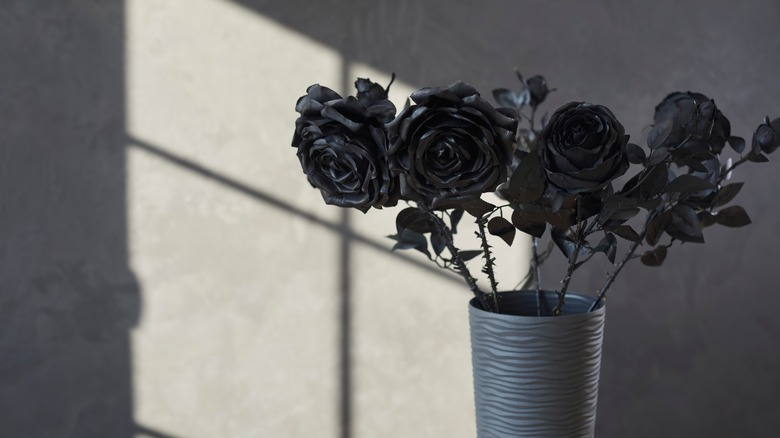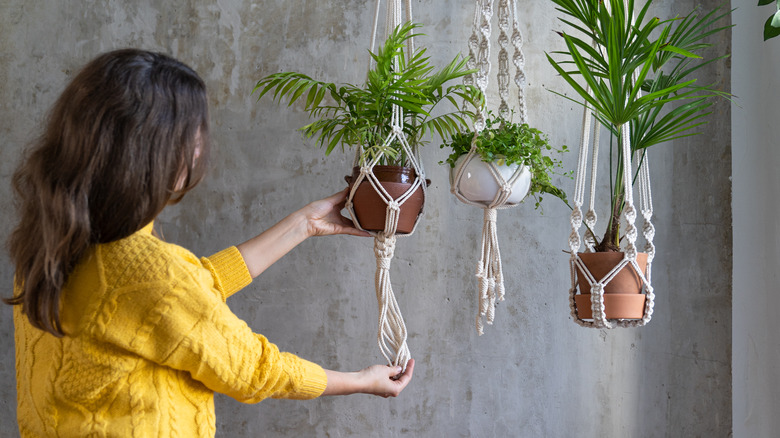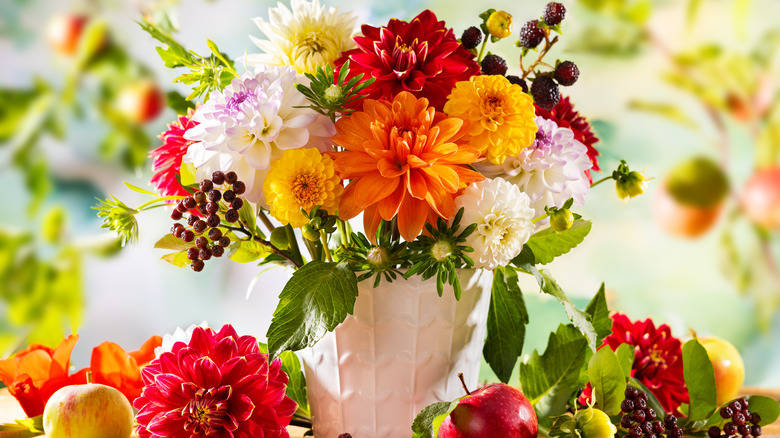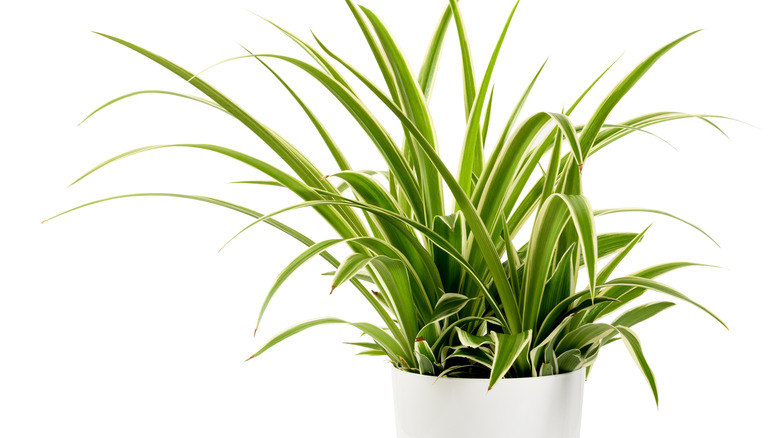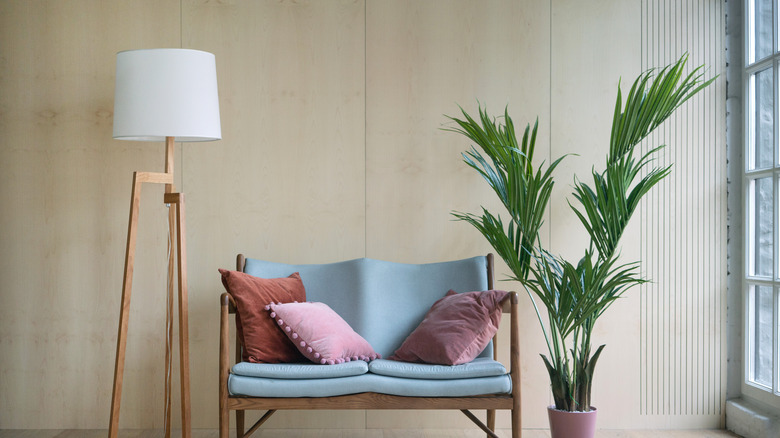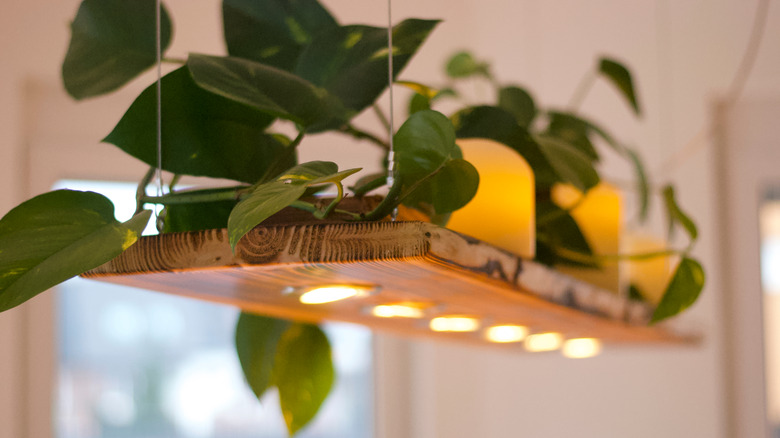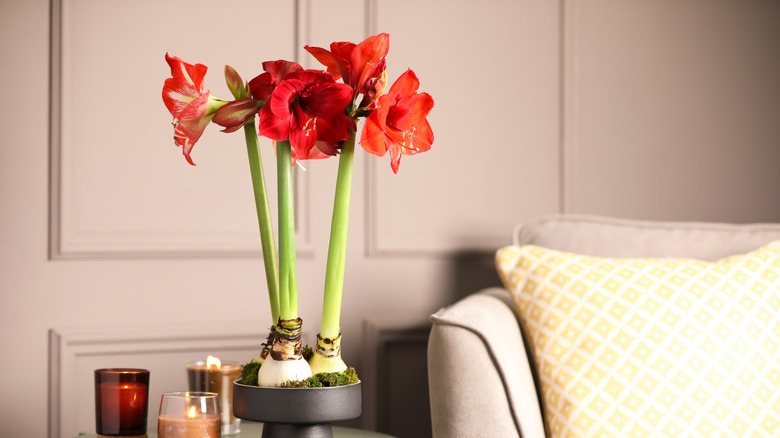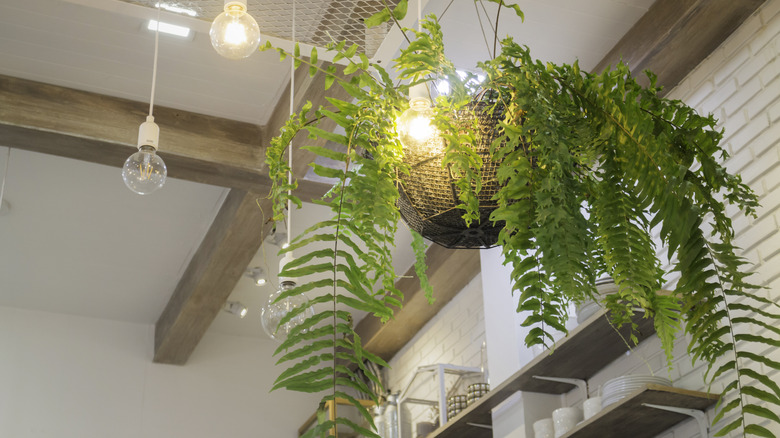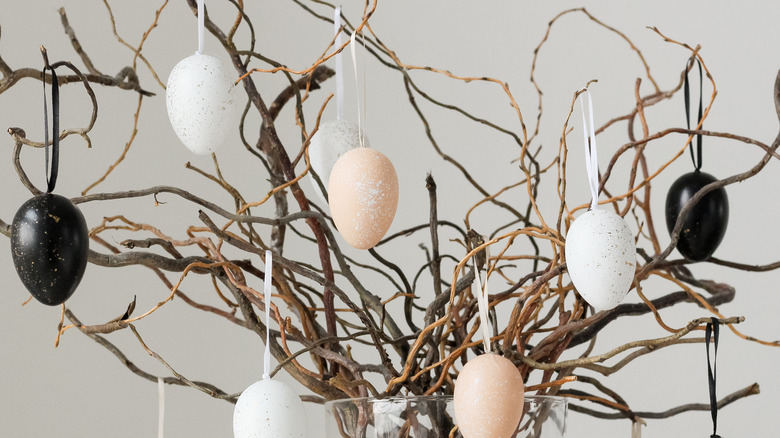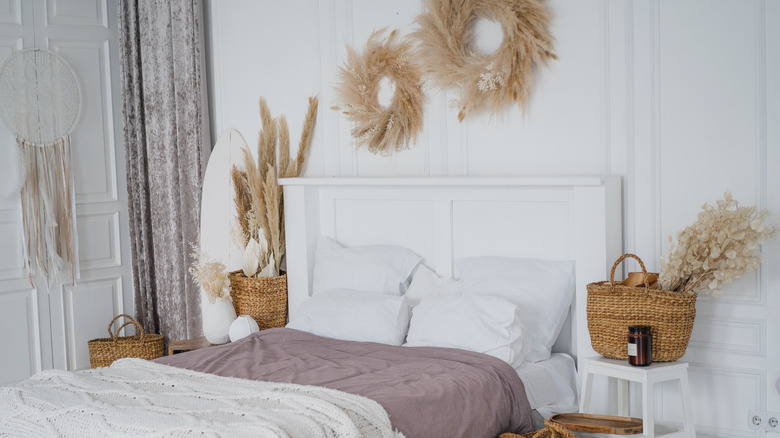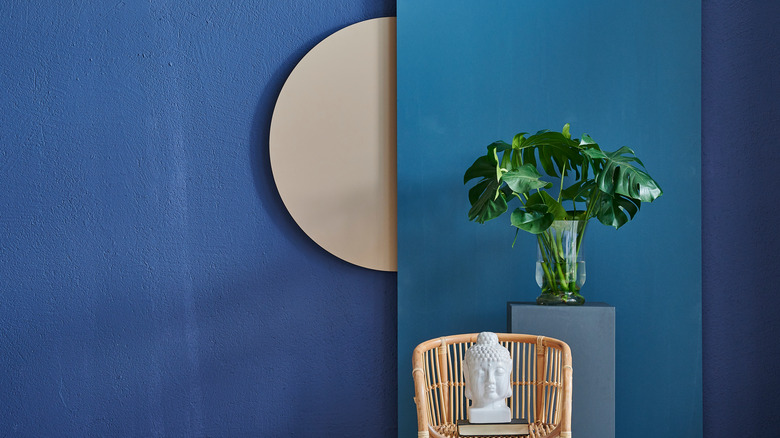Mistakes Everyone Makes When Buying Fake Plants
When we decorate with artificial plants and flowers, we should do so with an open mind. Reflect on your desired effect when selecting an artificial plant rather than buying on impulse and forcing a new look. Also, consider what's realistic given your space and particular decor style. According to Coveteur, there is an art to choosing fake plants. First off, you want to shop at stores that specialize in creating hyper-realistic pieces, such as Pottery Barn and The Sill. Next, you want to stick to plants with waxy leaves since they look more life-like than plastic or cloth leaves. "You can also get away with some fig and olive trees as leaves are thick and waxy," interior designer Celerie Kemble told the publication.
But even with these tips in mind, it can be tricky to pick out faux plants for the house. To keep regrets to a minimum, here are some common mistakes everyone makes when buying fake plants, and how to avoid them.
1. They use them to brighten up a naturally dark room
People have a strong urge to place a vibrant green or colorful plant in a dark corner to brighten up a gloomy room. But think about it. Would a natural plant flourish in a dark room? Nope. If your idea is to add faux greenery to your home, reflect on where a real plant would thrive first. As explained by HGTV, artificial plants are supposed to trick the eye, not present as unapologetically fake.
Do some research to find out which plants thrive in low light. In fact, why not go all-in and ask an indoor plant retailer for their recommendation? Additionally, pull out your interior decorator skills — you know you have some — and get creative. There's no rule that you must use a plant to lighten up a room. Instead, choose a stylish lamp or hang a mirror or framed picture to reflect the light in the corner.
2. They buy too many
Have you ever had to visit someone with a cramped living room? Maybe a grandma or aunt's house where each wall is covered from floor to ceiling with photographs, art, display cases, and every surface covered with doilies, bowls of candy, candles, and tissue boxes? It can get a bit overwhelming. If you share the tendency to over-decorate, use caution. Filling a space with fake plants and flowers can result in a stuffy, uncomfortable space that's hard to relax in, as the folks at Cort Furniture corroborate.
We, humans, are strange creatures. Once we've decluttered and added quality fake plants — even aimed for a pleasant feng shui atmosphere — the compulsion to add more green sneaks up on us fast. If this happens to you, you and your guests will soon be sitting in a living room jungle, wanting to escape just like you did from your grandma's house.
3. They cut corners
Of course, you want to save money! Most of us do. Unfortunately, it doesn't help you out in the long run to buy poorly made home decor of any kind. If you buy cheap artificial plants, you'll get cheap-looking plants. With silk flowers, for example, look for quality material and natural colors. Does the rose arrangement you're considering have race-car red, glossy petals, or pink blush, supple, and velvety petals? Use your instinct but look at the fine details too.
Go ahead and feel the petals and leaves of the arrangement that's caught your eye; the texture will reveal the state of its quality. Look at the edges of the plant as well. Poorly made fake plants often fray at the ends and their plastic stems look as fake as plastic toys. SFGate recommends you scrutinize beyond just the petals, and look at the base of the stalk, too. To see if the dirt resembles real dirt, inspect the outer sheath at the bottom end of the stalk.
4. They choose plastic plants and flowers
Yet another unfortunate shortcut: Buying plastic plants. Don't do it! Just kidding — nothing is that cut and dry. High-quality plastic snake or monstera plants, as suggested by The Spruce, may look great and can pass off as "real." However, this is often not the case. Plastic houseplants tend to look like, well, plastic. Look into other materials like cloth, rayon, and even paper flowers arrangements for a more natural effect.
You also want to look for an artificial plant with some imperfections, since that's what natural plants look like. Look for faux plants with irregular leaves, imperfect branches, a few brown spots, and color irregularities. It's also helpful to play with the leaf and branch placements once you get it home. "[Be sure to] take some time to prune and bend the leaves into a more natural presentation after unpackaging," Betsy Moyer, co-founder of the design firm Retreat, told the publication.
5. They let dust gather on them
Perhaps this has happened to you. You're just relaxing on the couch and happen to glance at the side table only to see a layer of dust. Then you see it on the lamp, the lampshade — everywhere! Well, fake plants gather dust, too. And because most plants lack straight surfaces, it's tempting to do a quick feather dusting. But if you want to keep your fake plants and flowers looking good, clean them well. And regularly.
There are several tactics to try. According to Apartment Therapy, you can clean your fake plant weekly with a microfiber duster, dust it with a damp cloth leaf-by-leaf, or set the pot in a plastic bag and hold the plant under the shower. Try out a few approaches until you find the method that works best for you. Once you have a schedule going, you may be inspired to improve your living space cleaning routine.
6. They create formulaic arrangements
Sure, there's a time and place for flower arrangements, like birthdays, funerals, and weddings. But if you want the look of a stylish and natural plant in your home, opting for faux flowers is tricky. Certainly, creating a pleasing fake floral arrangement is possible. You can do so successfully if you take some time to select the flowers and greenery that look nice together. Refer to great sources like Flowers Talk Tivoli for expert floral design and color theory for tips. Sanctuary Home Decor also recommends opening some of the flowers to create different shapes, and trimming some of the stems so they're not all uniform in the vase.
However, the most important tip for creating natural floral arrangements is regularly changing them out. How many days does a birthday bouquet look fresh? Of course, it depends on the flower, but probably about a week. Swap out your bouquets weekly or bi-weekly to make the arrangement seem real.
7. They don't incorporate low-maintenance plants
Perhaps you believe your green thumb is dead brown, so you don't think you can take care of a living plant. If so, you may be unaware of the many low-maintenance plants available. According to Homes to Love, air plants, succulents, palms, snake plants, and other varieties take little to no skill to keep alive.
Why should you consider buying real houseplants when you're determined to decorate with artificial ones? Interior designers recommend mixing faux plants with real ones to help them look more natural. This is especially true if you want to put fake plants in dark corners. "It will help make the spots where you use faux only—be it a high shelf or a dark corner — seem natural and organic and less out of place within your greater decorating scheme," Erin Marino of The Sill tells Apartment Therapy. To help the artificial plants blend in with their surroundings, try to group like plants together. "If you're able to use faux plants that have similar light and care requirements to the live plants they're grouped with, even better," she says.
8. It doesn't match the home decor
So you're bored with your home or apartment. You were into an industrial phase a while back and now you want an overhaul. Take a moment before you get online to purchase primary color-coordinated decor and a ROYGBIV floral arrangement. Feng Shui for Real Life recommends starting slow and investing in high-quality, pricier plants.
Think about what you want your aesthetic to be. Fake plants can help bring out certain themes and add fun pops of color. "Consider the type of vibe you want to create. Ferns tend to suggest a more natural feel, while a topiary is likely to represent neatness and tidiness," Rhianna Miller, a garden design expert with Rubber Mulch, told Apartment Therapy. "Don't be afraid to mix and match the different styles in your rooms."
You also want to consider what is missing in the room, and add a plant to fill that need. "When deciding on locations for your plants, it's important to remember that you want your plant to work for you, so think about what's missing," Miller said. If you have an empty color or a room is feeling sterile, a well-chosen fake plant can help nix that issue.
9. They're used in lackluster DIYs
The art of plant arrangement can be a fun challenge, but some people use them in lackluster DIYs, which further accents their artificialness. If you want to DIY fake plants, try DIYs that help makes them appear more natural. This can include adding real dirt, swapping out their containers, or adding natural elements like leaves or sprigs. "If your plant comes pre-potted, add a layer of soil to the planter to make it feel fresh," Callahan told Apartment Therapy. You also want to change the container to something that matches your own home decor, and if you're playing with a potted tree, add some rocks to the pot to make it look more natural.
"What we personally like doing is filling the planter with white stones or moss. If it's an eight or 10-foot plant, it's a good idea to fill the pot completely with rocks to help stabilize the plant, then add an extra layer of stone or moss on top," Frank Daniel, co-founder of Artiplanto, told the publication. Also, don't be afraid to play with the leaves. "Google images of the real plant, and shape your new faux one to match," Callahan said. "It will act as a guideline for bending and manipulating the stems and leaves until they feel more organic."
10. They overuse the same color
Your favorite color may be yellow, but if you use it as the main color for every room in the house, you might be overdoing it. There is no judgment here; many of us tend to rely on the things we know we like. Awareness is half the battle. If your home decor has an ivory palate in all shared spaces, go for something other than an ivory-white orchid, as per Ixia Flowers. Yes, high-quality fake white orchids are exceptionally beautiful but disappear into the background of a white, white, white detailed home. If this sounds like your home, try a splash of color, like a fake, triumphant red iris. A bamboo palm might not just add color, but texture, as the tropical leaves attract the eye.
You also want to choose flowers that match your aesthetic. If you have a boho room, choose tropical flowers. If you have a maximalist design, choose colorful or sculptural blooms. And if you have classic decor, choose timeless bouquets like tulips or roses.
11. They neglect the pot
It's so obvious it's easily overlooked. You don't have to accept the drab, plastic pot that comes with your artificial plant. You can tell a fake plant by looking at its pot. And that won't be hard to notice, as low-quality or mismatching pots are easy to spot. According to Silks Are Forever, it's a design faux pas to spend money on a quality artificial plant, only to leave it in its starter pot.
Why not change out that pot your plant came with for a lovely terra cotta or colorful vase? Also important in selecting the right pot is the appropriate fit. Pacific Silkscapes notes that leaving a faux tree in a tiny pot cheapens its aesthetic and makes it look glaringly fake. It's kind of like leaving a live tree in its nursery pot!
For best results, go for a hand-made terra cotta or a colorful glazed pot, depending on your current color scheme. If you feel you can branch out (no pun intended!), try a transparent pot that reveals the roots and soil. But make sure that dirt looks natural or that it is real.
12. They don't use fake plants during the holidays
Halloween, Valentine's Day, Christmas, and St. Patrick's Day are all great celebratory occasions to use fake plants! Artificial Christmas trees are a common tradition for many families, for example. Some enthusiasts go all out on fake holiday trees and underscore the artificial with fake snow and multicolored lights. So what's wrong with that? Nothing at all. Honestly, go wild! It comes down to your taste, what you like, and what decoration will make you feel good and happy for the holiday at hand.
Search your favorite crafty websites for ideas. Florsani presents a number of decorative artificial plant projects for Halloween, many of which you may find tasteful. If you want some stricter guidelines, simply refer to the advice you've gleaned from what you've read here. Apply the same rules. Think about the iconic images of a season — like Easter lilies or Valentine's Day roses — and brainstorm plant types and colors that pair well.
13. Choosing poor quality wreaths
Artificial wreaths are yet another pitfall you should know about if you want to improve the ambiance of your home. A common mistake is opting for poor-quality materials and assemblage. A cheap wreath is, indeed, a quick fix. It takes little forethought on your part. But just as there are brilliantly made fake plants, you'll be pleased to know about the numerous wreath options available. Wreaths at Home offers a comprehensive look at quality artificial wreaths. Common options include fake ivy, eucalyptus, evergreen, and bay leaves, for example. Of course, if you find a high-quality, silky green or floral combination wreath, go for it.
An often-overlooked alternative is fake pampas grass wreathes. Again, look for a premium-made, fluffy pampas wreath, says House Beautiful, as poorly made versions will not only have a dull appearance but will shed over time. One method to counteract shedding is to treat it with hairspray. Not too much, though, just enough to stabilize the fluff and maintain its fullness. Do it right, and this subtle, earthy decoration can elevate the mood of your home interior.
14. Decorating in shame
So you've decided to include some fake plants! Yay! Honestly, there is nothing inherently wrong with artificial plants or flowers. In fact, they have the potential to boost mental health and well-being, as suggested by Interior Landscaping Products. The faux pas is to make fake plants look fake by unconsciously making poor choices. Remember to place plants in areas of your home where they would thrive naturally or illuminate the space first, then add a plant. Choose quality plants over quantity, and select attractive pots as well, even if that means you need to do some repotting.
Don't forget to clean and care for your artificial plants and flowers. And if you go for seasonal plants and floral arrangements, change with the season! Honestly, this is an opportunity to elevate your home's mood, work your creative muscles, and add beauty to your home, not just for yourself but for those you live with!
